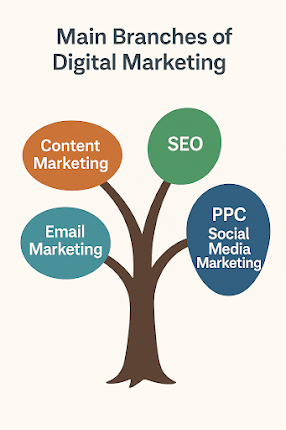"Mastering Digital Marketing: Strategies, Funnels & Key Branches Explained"
A Beginner’s Guide to Digital Marketing: What It Is, How It Works & Risks to Know
From Google search results to Instagram advertising, digital marketing is ubiquitous. It's how companies interact with their customers on the internet. This guide makes digital marketing easier for everyone, whether you're a student, business owner, or just interested in learning more.
---
What Is Digital Marketing?
The promotion of goods and services via the use of digital tools and the internet is known as digital marketing. Digital marketing takes place online—on websites, social media, email, and search engines—in contrast to traditional marketing (such newspapers or billboards).
Main Branches of Digital Marketing (Tree Diagram)
Here's a tree-style breakdown:
Digital Marketing
Let’s explore each branch in a friendly way:
1. Search engine optimisation (SEO)
Your website will rank higher in Google searches thanks to SEO. If you sell handmade soaps, for instance, SEO can help your website show up when people search for "organic soaps online." Important strategies: Making use of the right keywords Websites that load quickly with high-quality content
---
2. Content Marketing
The goal of content marketing is to draw in and inform your audience by producing informative content, such as blogs, videos, or manuals.
Example: On their blog, a fitness company offers workout advice and nutritious food.
Goals: Educate clients and foster trust.
---
3. Social Media Marketing
Reaching your audience using social media sites like Facebook, Instagram, and LinkedIn is part of this. Example: In order to increase sales, a bakery shares pictures of delicious cakes on Instagram. Increase sales, foster a sense of community, and engage followers.
---
4.PPC (Pay Per Click) advertising
Every time an ad is clicked, you pay in PPC. For instance, you are running a Google Ad for "Buy Shoes Online." You only have to pay when an ad is clicked. Well-known platforms: Google Ads Facebook advertisements YouTube Commercials
---
5. Email Marketing
emailing your audience with deals, advice, or updates. A bookshop, for instance, recommends books in its weekly mailings. The best methods: Give the message a personal touch. Steer clear of spammy websites.
---
6. Marketing Using Affiliates
By promoting other people's goods, you can get paid when someone purchases something using your link. An example would be a blogger who reviews headphones and provides a link to Amazon. Should a purchase be made via it, the blogger will receive a commission.
---
7. Influencer Marketing
Partnering with influencers (people with large followings) to promote your product.
Example: A fashion brand sends clothes to a famous Instagram model who wears and promotes them.
---
Digital Marketing Funnel (Tree Image)
---
Benefits of Digital Marketing
Cost-effective
Can reach a global audience
Real-time results and tracking
Highly targeted campaigns
---
Risk Factors in Digital Marketing
Like every other tactic, digital marketing has its risks.
1. A fierce rivalry Since everyone uses the internet, it's challenging to stand out.
2. Changes in Algorithms Information ranking and display are regularly altered by social media and Google.
3. The Fatigue of Advertising Seeing the same ads over and over again might wear people out.
4. privacy issues. Because of laws like the GDPR, users are becoming more cautious when providing data.
5. Platform dependence If the platform changes, relying too much on one channel (like Instagram) can be dangerous.
---
Conclusion: Start Small, Learn Daily
Any firm may benefit greatly from digital marketing, but it requires patience, education, and trial and error. See what works for your audience by starting small, such as with an email newsletter, Instagram page, or blog. Do you want to grow more quickly? Try advertisements, learn SEO, or get assistance from professionals. But the digital game is to continually keep learning.





Comments
Post a Comment